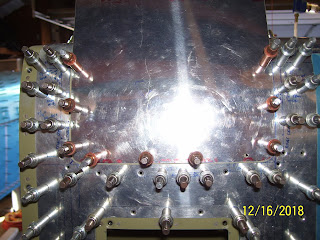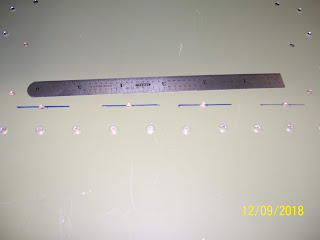Anyway, it all started with the cutoff wheel on the Dremel tool again, with the sheet clamped to the table. I tried to leave about 1/16th of an inch on the two sides that I cut to allow for final trimming of a custom fit. This was going fine because I was able to keep both hands on the tool while cutting, and I made the cuts from right to left to keep the wheel from binding up and jumping out of the cut, until I got to the very end of the second cut. I had forgotten that by that time the part's own weight was going to force it to bend just before I finished the cut, and when that started to happen I had to reach and hold the part with my left hand, and this caused the wheel to chew on a small part of he edge a bit more than I had wanted. SO I was not happy with that, but I had already reasoned that I may be making two or three more of these until I was completely satisfied with the fit. SO I did not get too terribly bent out of shape about it.
Here is the sheet after completing the first cut on the longer edge:
My original plan for preserving the integrity of the part and keeping it from being damaged after it fell away from the rest of the sheet was to allow it to come to a soft landing on some blankets that I strategically placed under the part on the floor as shown below:
And here is the corner of the edge that got mucked up a bit after I tried to catch it with one hand as it began to bend away from the sheet when I got about an inch away from the corner with the cutoff wheel.
After I separated the part from the sheet, next stop was over to the scotch brite wheel for many edge-smoothing and trimming sessions. Here is shot of the part immediately after removing it from the sheet with the cutoff wheel. Its not real hard to see where the nice clean factory-cut edges are and where I rough-cut them with the cutoff wheel.
I was so glad I was able to use that tool instead of resorting to files and sandpaper like I had to do on the LE skin, which is way to big and cumbersome to be able to use the wheel. After the initial corner forming and edge smoothing and straightening, next came the long painful process of trial fitting the part with the LE. Fr some unknown reason I decided to start with the top side, not quite knowing what I was going to do once I got to the point where it wraps around the front and on the bottom side. I was pleasantly shocked to see that most of the rear edge clecoes and the sides were aligned quite nicely. the left edge was laying down very nicely next to the edge of the LE skin on that side, and the rough cut edge was overlapping the other side, but not by much.
Next is a series of pics after I got the corners shaped enough to allow them to sit flush on both sides. There are some gaps, but as I mentioned before, this may be OK to allow for layers of primer, paint and sealer when that day comes. All I was interested in right now was the general overall fit f the part so that it would lay flush on the surface of the subskin, and as close to the edges as possible, with all screw holes clecoed in place and aligned. If I could achieve that on attempt one I would be very happy.
With the top side fitted, I removed the part from the top and moved it to the bottom, where I repeated the same fitting, scotch brite, refitting, cleoeing exercise that I performed on the top side:
On the bottom right rear corner you can see the one single hole that is not clecoed. That turned out to be the ONLY hole that was not properly aligned with the hole in the subskin. Unfortunately there is nothing I can do to fix that problem other than mark and drill a new hole in a new part, meaning that this one is "toast" because of that issue alone, let alone any of the other edge gap issues that also exist. Unfortunately the misalignment is so bad that I cannot just fix it when I up-drill the #30 hole to the #19 hole, so that means I whole new part has to be fabricated. Here is a blurry close up of that hole where you can just see how badly misaligned it is.
And here you can see the gapping on the left side of the bottom edge. The pic makes it looks much worse than it really is, but it is quite noticeable, compared to how the other edges are lining up with the LE skin.
And here are a couple more showing the gap along the bottom and right side edges of the bottom portion of the part:
At some point I decided that instead of marking up a second part I was going to go ahead and check the fit of everything AFTER wrapping the skin from bottom to top and securing it on both sides to see how well that worked out. ONce the edges on either side, the corners, and the rear-most edges were proven to allow the part to rest correctly against the subskin on both sides without any overlapping or interference with the LE skin, I started out with everything clecoed in place on the bottom, and then just used my hands to easily bend the aluminum around the front and over the top side. TO my amazement everything laid down on the subskin as expected. I clecoed the holes in progression from the bottom side up, and then the top side down, secring the edges as each hole lined up with the hole in the subskin. It fit like a glove.
So it was looking good until I checked the following area. Just as I had mentioned before when I noticed the LE skin does not quite sit completely flush with the subskin in the very front, right where it curves. The inboard side of the LE fits a little better than the outboard side. Well, true to form, the part, just like the file folder template, laid down very nicely on the top of the subskin, but there is a complete mismatch where the LE skin curves around, and the new part was very noticeably mis-aligned with the curvature of the LE skin.
As I also previously stated, my plan to address this in the easiest manner is to build the removeable part up with fiberglass or carbon fiber so that it matches the contour of curvature on either side of the LE. SO that will take a little bit of some unplanned work to take care of that little issue. It is better to fic this problem that way, so that the part lies flush against the subskin, than to try to adjust screw hole locations or skin size to get the right "bend" in everything. So, the MOST important thing about this is that one way or the other, the removeable section WILL properly align with the contour of the rest of the LE when it is all finished up. There was already plenty of other fiberglass work to do when I add the lighted gun ports to the front of this part, and so now that it looks like I will also need to do some composite work on the "normal" part with no gun ports, I guess that will just be more practice opportunities for me to get it right before I mess with the "funner" stuff.
The last pic I took today is just to show that from a distance, except for all the new clecoes in all the new holes for everything, it looks just like it used to look before all the measuring and cutting took place. When all those hole are riveted in place it will even more like the regular old un-modified LE that it used to be. So, just as with everything else on this project, I feel 90% done with all this, with 90% more left to go. But at least most o the hard work is done, until I get around to doing it all over again for the right wing.
All for now. KPR




























































